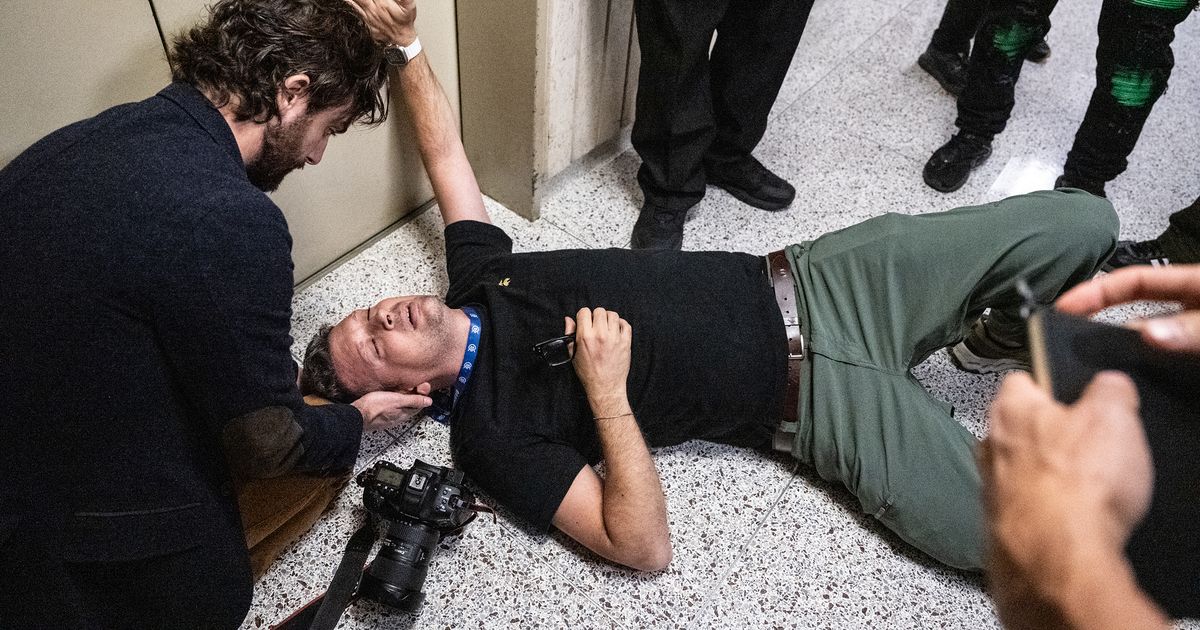The Incident: When Immigration Enforcement Meets Press Freedom
The halls of 26 Federal Plaza in Manhattan became the scene of a disturbing confrontation on Tuesday when freelance photojournalist Stephanie Keith was hospitalized following what witnesses describe as a chaotic encounter with federal immigration enforcement agents. The incident, captured on video and reported by multiple media outlets, has sparked renewed debate about press freedom, federal law enforcement tactics, and the rights of journalists to document government operations.
Keith, an experienced photojournalist known for her coverage of immigration issues and social justice topics, was on assignment when the confrontation occurred on the building’s 12th floor. Video footage shows what witnesses described as “wild scenes” involving multiple ICE (Immigration and Customs Enforcement) agents, raising serious questions about the circumstances that led to a working journalist requiring medical attention.
Understanding the Context: 26 Federal Plaza’s Significance
26 Federal Plaza serves as a critical hub for federal immigration proceedings in New York City. The building houses immigration courts, ICE offices, and other federal agencies responsible for processing the cases of thousands of immigrants annually. For photojournalists like Keith, documenting activities at this location provides crucial insight into the human impact of federal immigration policy.
The building has long been a focal point for both immigration proceedings and protests. Families often gather outside waiting for news about loved ones, while advocacy groups regularly organize demonstrations to highlight immigration issues. This intersection of personal drama and policy implementation makes it a newsworthy location that journalists frequently cover.
The Role of Immigration Journalism
Photojournalists covering immigration issues face unique challenges. They must navigate complex legal environments, sensitive family situations, and often tense interactions with federal agents. Their work serves a vital public interest by documenting how immigration policies affect real people and ensuring transparency in government operations.
Legal Framework: Press Rights in Federal Buildings
The incident raises important questions about journalists’ rights to access and document activities in federal buildings. While government facilities maintain security protocols, the First Amendment generally protects journalists’ right to gather news in public spaces. However, the boundaries become more complex in federal buildings where security concerns and operational considerations intersect with press freedom.
Legal experts note that federal agents have broad authority within federal facilities, but this authority must be balanced against constitutional protections for the press. The specific circumstances of Keith’s case – including whether she had proper credentials, was following established protocols, and was interfering with official duties – will likely be scrutinized as the incident is investigated.
Historical Precedent and Press Access
This incident is not isolated. Journalists covering immigration enforcement have increasingly reported hostile encounters with federal agents. From detention facilities at the border to immigration courts in major cities, reporters have documented a pattern of limited access and, in some cases, aggressive responses to journalistic activities.
The Committee to Protect Journalists and other press freedom organizations have documented numerous cases where immigration reporters have faced intimidation, surveillance, or physical interference with their work. These incidents collectively paint a concerning picture of the relationship between immigration enforcement and press freedom.
The Broader Implications for Press Freedom
Keith’s hospitalization represents more than an isolated incident – it symbolizes the broader challenges facing journalists who cover controversial government operations. When reporters face physical harm while documenting federal activities, it creates a chilling effect that can limit public access to important information.
Press freedom advocates argue that incidents like this one demonstrate the need for clearer protocols governing interactions between federal agents and journalists. Without proper guidelines and training, similar confrontations may continue to occur, potentially escalating into more serious incidents.
Impact on Immigration Coverage
The immigration beat has become increasingly difficult for journalists to cover effectively. Limited access to detention facilities, restrictions on photographing certain proceedings, and now physical confrontations with agents all contribute to an environment where the public may have incomplete information about how immigration policies are implemented.
This information gap has significant implications for democratic accountability. When journalists cannot safely and effectively cover government operations, the public loses a crucial check on federal power.
Agency Response and Accountability
As of the incident’s reporting, ICE has not provided a detailed public statement about the circumstances that led to Keith’s hospitalization. This lack of transparency is itself concerning, as it prevents the public from understanding what protocols were followed and whether any policies were violated.
Federal agencies typically have internal review processes for incidents involving civilians, especially when medical attention is required. However, these processes are often opaque and may not provide sufficient accountability for actions that affect constitutional rights.
The Need for Systemic Reform
Beyond the immediate circumstances of Keith’s case, the incident highlights the need for systematic reforms in how federal agents are trained to interact with journalists. Clear guidelines, regular training, and accountability mechanisms could help prevent similar incidents while respecting both security needs and constitutional rights.
Moving Forward: Lessons and Recommendations
This incident should serve as a catalyst for meaningful dialogue between federal agencies, press freedom organizations, and media outlets. Establishing clear protocols for journalist access to federal facilities, providing training for agents on press rights, and creating transparent accountability mechanisms are all essential steps.
Media organizations also have a role to play in ensuring their journalists are properly prepared for potentially challenging assignments. This includes legal training, safety protocols, and advocacy support when incidents occur.
Ultimately, the health of American democracy depends on the ability of journalists to safely and effectively cover government operations. When that ability is compromised, whether through policy restrictions or physical confrontations, the entire system of democratic accountability suffers.
Key Takeaways
- Press Freedom at Risk: The hospitalization of photojournalist Stephanie Keith highlights growing tensions between immigration enforcement and press access
- Legal Complexities: Journalists’ rights in federal buildings involve balancing First Amendment protections with security protocols and operational needs
- Systemic Issues: This incident reflects broader challenges facing reporters who cover immigration enforcement, including limited access and hostile encounters
- Accountability Gap: The lack of detailed information about the incident demonstrates the need for greater transparency in federal agency operations
- Democratic Implications: When journalists cannot safely cover government operations, public oversight and accountability suffer
- Need for Reform: Clear protocols, training, and accountability mechanisms are essential to prevent similar incidents while protecting both security and constitutional rights
This article is based on reporting from the original source

Born and raised amidst the hustle and bustle of the Big Apple, I’ve witnessed the city’s many exciting phases. When I’m not exploring the city or penning down my thoughts, you can find me sipping on a cup of coffee at my favorite local café, playing chess or planning my next trip. For the last twelve years, I’ve been living in South Williamsburg with my partner Berenike.

